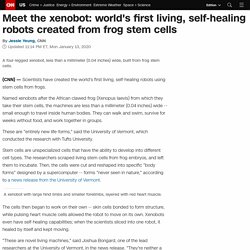

ジオニック社 公式MS(モビルスーツ)講習コース ZEONIC TECHNICS. Should Children Form Emotional Bonds With Robots? Stefania Druga and Randi Williams, the researchers behind the study, want to know how children perceive smart robots, and, eventually, to study how those bots affect kids’ cognitive development.

So far, they’ve discovered that little children (ages 3 and 4) aren’t sure whether the robots are smarter than they are, but that slightly older children (ages 6 to 10) believe the robots to have superior intelligence. Druga and Williams were inspired by the research of the legendary Sherry Turkle, who wrote a highly influential 1984 book called The Second Self. She argued that computers, as objects that exist somewhere between the animate and the inanimate, force humans to reexamine their own minds. Small children, she found, were fascinated by the question of whether computerized toys were alive, dead, or something else. Finished charging, Cozmo came rolling out of its base station with some little bleeps.
Cozmo lifted its arm over the cube. It was bath time. It was bath time. Lovot final production model hands-on at CES 2020. Xenobots: First living robots created from stem cells. Named xenobots after the African clawed frog (Xenopus laevis) from which they take their stem cells, the machines are less than a millimeter (0.04 inches) wide -- small enough to travel inside human bodies.

They can walk and swim, survive for weeks without food, and work together in groups. These are "entirely new life-forms," said the University of Vermont, which conducted the research with Tufts University. Stem cells are unspecialized cells that have the ability to develop into different cell types. The researchers scraped living stem cells from frog embryos, and left them to incubate. Then, the cells were cut and reshaped into specific "body forms" designed by a supercomputer -- forms "never seen in nature," according to a news release from the University of Vermont.
The cells then began to work on their own -- skin cells bonded to form structure, while pulsing heart muscle cells allowed the robot to move on its own. How to Hack Your Furby Connect- A Beginner’s Guide - Chloe Condon. The 1990s were a wild time for pop culture and trivia.

As someone born in 1989 (please save the eyerolls elder-devs; we all have no choice in our release date on this Earth) the late 90s bring back overwhelming nostalgia of Nicktoons, Disney Channel Original movies, and very bizarre straight to VHS videos from the Olsen Twins. Of course, back in our day, we didn’t have Hulu & Netflix… we had cable TV. Which meant commercials. Which meant brainwashing us into needing the newest coolest toy being advertised to us between episodes of Rocko’s Modern Life. True fact: I don’t have my partner of 3 years’ cell phone number memorized, but I can sing every lyric in this Nano Baby ad (among many others). With the 2000s and Y2K just around the riverbend (yes, Pocahantas was ‘95), it seemed like every new toy was trying to be the newest gadget that kids of the new millennium would beg their parents for.
Which brings us to the Furby… the hottest toy of 1998. Step 1: Install fluffd & fluffd-client. Meet openDog — The Open-Source Robotic Dog. If you’re familiar with robotics in popular culture then you’ll recognize the name Boston Dynamics, a robotics development company that rose to stardom through viral videos of its dog-like robots.

Boston Dynamics is a subsidiary of the for-profit company SoftBank, which is looking to sell Boston Dynamics’ robot technology to military and industrial buyers. Unfortunately for us makers, this means that all the designs and plans for these robots are unavailable for public consumption. Former toy designer and maker James Burton is looking to change this through his openDog project. On his Youtube channel, James documents the process of constructing his open-source quadruped robot.
He takes us all the way from designing and CAD through construction and programming. All of the software and CAD files are available on GitHub, organized by the files he uses in each YouTube episode. openDog cannot yet walk, but through a control pad James can control how the robot stands and balances itself.